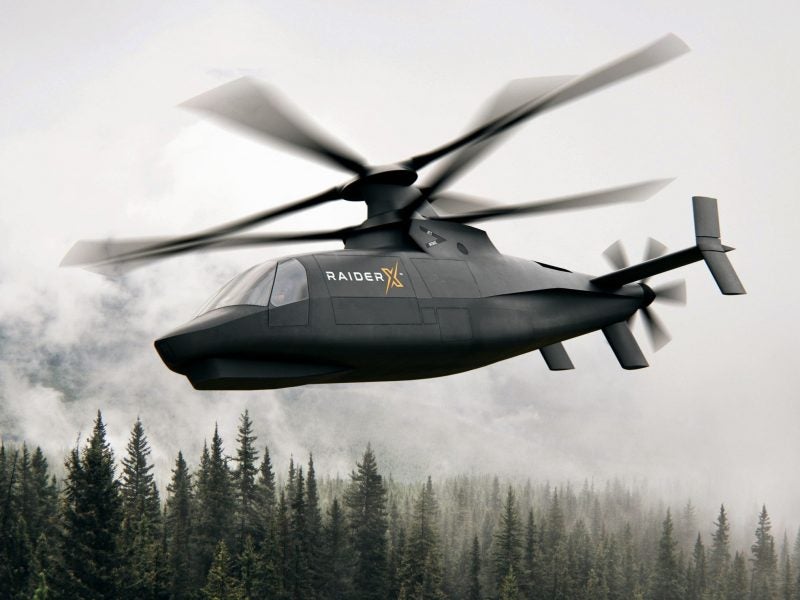
The company joins Bell in submitting a rotorcraft for the programme with its RAIDER X, a ‘NextGen’ light-attack reconnaissance helicopter.
Lockheed Martin Rotary and Mission Systems executive vice president Frank St. John said: “RAIDER X converges everything we’ve learned in years of developing, testing and refining X2 Technology and delivers warfighters a dominant, survivable and intelligent system that will excel in tomorrow’s battlespace where aviation overmatch is critical.”

Discover B2B Marketing That Performs
Combine business intelligence and editorial excellence to reach engaged professionals across 36 leading media platforms.
Sikorsky, owned by Lockheed Martin, said the vehicle would build on Sikorsky’s X2 technology demonstrator and would give the US Army ‘the reach, protection and lethality required to remain victorious in future conflicts’.
St. John added: “The X2 Technology family of aircraft is a low-risk solution and is scalable based on our customers’ requirements.”
In a press release, Sikorsky claimed the RAIDER X would offer the US Army exceptional performance and adaptability’ using an open systems architecture and enhanced mission flexibility with a range of different configurations. Sikorsky claims the RAIDER X can reach speeds of 250 knots and fly as high as 9,000 feet.
Sikorsky president Dan Schultz said: “RAIDER X is the culmination of decades of development, and a testament to our innovation and passion for solving our customers’ needs, by leveraging the strength of the entire Lockheed Martin Corporation, we will deliver the only solution that gives the US Army the superiority needed to meet its mission requirements.”

US Tariffs are shifting - will you react or anticipate?
Don’t let policy changes catch you off guard. Stay proactive with real-time data and expert analysis.
By GlobalDataSikorsky is the latest entrant in the FARA programme that will see the army choosing between multiple designs including the RAIDER X and Bell Textron 360 Invictus.
Bell unveiled the 360 Invictus at the start of October, which they say offers the US Army ‘an affordable, agile and lethal solution to win on the modern battlefield’.
Bell executive vice president of military business Vince Tobin announced the product, saying: “The Bell 360 will deliver advanced battlefield situational awareness, as well as lethal options, in support of the manoeuvre force at an affordable cost.
“The multi-domain fight will be complex, and our team is delivering a highly capable, low-risk solution to confidently meet operational requirements with a sustainable fleet.”
Like Sikorsky’s offering, Bell’s entry can also travel over 200 knots. The helicopter is also equipped with a 20mm cannon but can be outfitted with air-launched effects; the company says the aircraft will also be able to host ‘future weapons’.
Bell vice president of Advanced Vertical Lift Systems Keith Flail said: “Bell is committed to providing the US Army with the most affordable, most sustainable, least complex, and lowest risk solution among the potential FARA configurations while meeting all requirements.”
Both rotorcraft have been submitted to the competition which should see prototypes in the air by 2023 as part of a wider push for new Future Vertical Lift (FTV) capabilities. The competition saw five entries which the army will later whittle down to two in 2020.
Earlier this year speaking at US Army’s Global Force Symposium Brigadier General Walter Rugen said the programme would deliver ‘the greatest armed reconnaissance helicopter in the world’. Other companies involved in the programme are L-3 Communications Integrated Systems, Boeing and Karem Aircraft.
The result of the FARA programme will replace AH-64 Apache aircraft that were switched to reconnaissance duties and fill the capability gap left when OH-58D Kiowa Warrior was retired from service.
The US Army said previously: “The FARA shall be capable of achieving and sustaining overmatch against potential competitors and enduring asymmetric threats by closing or mitigating gaps in Army aviation attack and reconnaissance.”





